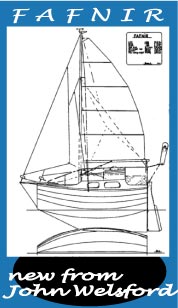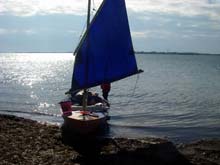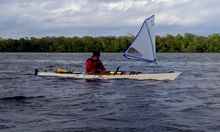
 Custom Search
|
| sails |
| plans |
| epoxy |
| rope/line |
| hardware |
| canoe/kayak |
| sailmaking |
| materials |
| models |
| media |
| tools |
| gear |
| join |
| home |
| indexes |
| classifieds |
| calendar |
| archives |
| about |
| links |
| Join Duckworks Get free newsletter CLICK HERE |
|
|
| The Everglades Challenge - 2013 |
by Gary Blankenship
- Talahassee, Florida - USA with comments in italics by Chuck Leinweber |
| Part 2: Day 2 part 1 - part 3 - part 4 - part 5 The wind returned with a vengeance around 5 am, rattling the boom tent. It enticed neither of us to rise early, but did manage to send some drafts through the tent that chilled us.
Around 6, the breeze seemed a more manageable velocity and shortly we were stirring and getting ready, as Chuck waded around the boat stowing the tent and restepping the masts. The plan was to take turns rowing to deep water to warm up and then sail on our way. Around 7, we were off. Rowing wasn't necessary for long as the brisk northeasterly had us moving toward Boca Grande Inlet under a single-reefed main. Charlotte Harbor always seems to be waiting with something special for me, and this year was no different. In 2012 a contrary wind and tide produced waves that nearly broached Oaracle. This year there was a negligible tide, but the strong wind had kicked up a healthy following sea that shoved us toward Cayo Costa. The white knuckle ride lasted across the inlet and up the outside of Cayo Costa until the shoals and islands offered some shelter. Striking the boom tent after the soggy night at Sandfly Key We paused at the southern end of Pelican Bay on Punta Blanca Island to attend to a couple minor boat things and address the handheld VHF. The clip holding the battery in place had broken. Some duct tape fixed it, but we were careful with it for the rest of the EC since its waterproof integrity was now questionable. When we resumed sailing, we found the wind had eased, so we set the mizzen. In a repeat of Saturday, the wind slackened as the morning went on, then shifted to the north and then northwest and strengthened. At the northern end of Pine Island Sound, we were doing 3.5 to 4 knots, but by the time we reached the southern end, we were back to 6-plus. One advantage to the cool temps and strong winds is it kept the powerboat traffic to a minimum. We made the jog to the east at the south end of the sound and encountered a couple special gusts of wind. That prompted a decision to put the second reef in the main. But when Chuck went to carry out that function, the wind seemed to strengthen even more, so he just dropped the main completely and we proceeded under the 24 square foot mizzen, still averaging better than 4 knots. Walkabout went under the fixed west span of the Sanibel Causeway. Later we learned that veteran Watertriber Marty Sullivan was on the causing filming our passage. He said it was pretty dramatic with the small mizzen and the large follwoing seas. We'd like to see that video!
Once through the bridge, we cut east to get some protection from the causeway and discussed our options. There was a temptation with the fair if strong following wind to head down the coast for Cape Romano, trading turns at the helm and hoping to make up in naps for the sleep we had missed the previous night. But concern about the size of the seas, the difficulty of seeing them approaching in the dark, and the potential for accumulating fatigue led to the decision to run in Matanzas Inlet and head down behind Fort Myers Beach on Estero Island, with the goal of making New Pass and spend the night in a tent on land (!) at Lovers Key State Park. About halfway to Matanzas we saw entering San Carlos Bay behind us what appeared to be a replica caravel or galleon. We speculated the source, certain only it wasn't a fellow Watertriber.
On to Estero and Fort Myers Beach. I had never been that way before and it made for an interesting trip. Seaward, nothing is visible but a line of high rise condos. But on the inland side, at least at the start, is a mix of marina, restaurants, bars, mom-and-pop motels, and the like. And those folks like their boats. Aside from the marinas, there are boats moored everywhere. Once in from the Gulf, we re-raised the reefed main and followed the well-marked waterway and eventually found ourselves in company with Justin Blais (Frenchman) in is class 1 (downwind sail only) kayak. He was heading to Wiggins Pass, a few miles past New Pass and also obtainable without going into the open Gulf.
The wind moderated somewhat and it was a pleasant sail. Soon we passed Big Carlos Pass and we could look out and see the northern end of Lovers Key. That key sits seaward of three or four other developed keys and stretches from Big Carlos to New Pass. The wind was partially blocked now and it took another 45 minutes to reach New Pass. With a now light and sometimes blocked wind and a bit of contrary tide, a little rowing was necessary to get through most of the pass. We beached at 6 p. m., with the sun heading for the western horizon. It was about high tide, so we pulled Walkabout as far as we could out of the water, knowing it would be safe until we relaunched in the morning. Chuck erected the two-man tent, we ate and puttered a bit and went to bed early. The wind, at least where we were, died again. It was another cold night, but we slept snug and warm in bedrolls. Next time: Day 3 Here is a video montage with clips from the entire EC: |
|





